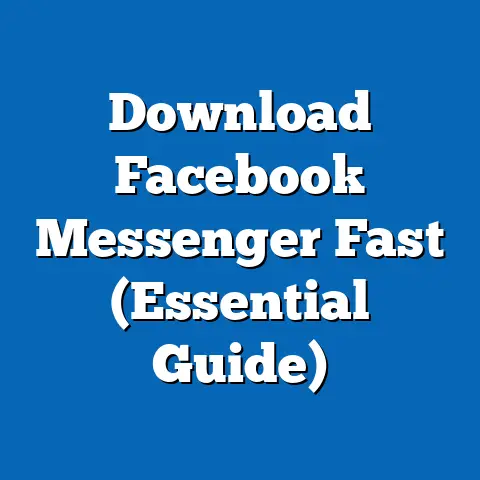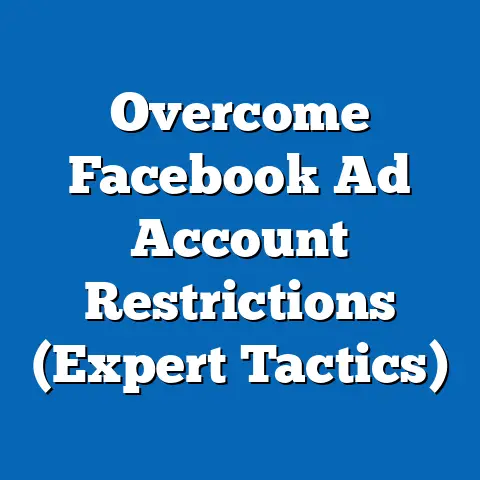Master Facebook Ad Currency (Unlock Profitable Strategy)
In the ever-evolving landscape of digital marketing, the strategic use of nostalgia has emerged as a powerful tool to connect with audiences on an emotional level. Nostalgia, a longing for the past often tied to personal or collective memories, resonates deeply with specific demographic groups, influencing their behaviors and decision-making processes, including in the realm of political and consumer engagement. This article delves into the concept of “Master Facebook Ad Currency,” a term that encapsulates the strategic deployment of targeted advertising on social media platforms to maximize engagement and conversion through emotional triggers like nostalgia, while analyzing the demographic makeup, core beliefs, voting patterns, and distinguishing characteristics of the audiences most receptive to such strategies.
By examining how nostalgia operates as a currency in digital advertising, particularly on platforms like Facebook, this analysis will uncover the profitable strategies that marketers and political operatives employ to influence behavior. We will explore the intersection of nostalgia-driven content with political messaging, supported by demographic data, polling statistics, and electoral trends. The goal is to provide a comprehensive, data-driven understanding of how nostalgia shapes engagement across different groups and its broader implications in the political and social context.
The Power of Nostalgia in Digital Advertising
Nostalgia is not merely a fleeting emotion; it is a potent psychological trigger that can evoke strong emotional responses, often leading to increased brand loyalty and political alignment. Research from the Journal of Consumer Research (2014) indicates that nostalgia can increase feelings of social connectedness and self-esteem, making individuals more receptive to messages that align with their past experiences or idealized memories. In the context of Facebook advertising, leveraging nostalgia involves crafting content that resonates with shared cultural touchstones—think retro imagery, references to past decades, or callbacks to “simpler times”—to create an emotional bond with the target audience.
This strategy is particularly effective on platforms like Facebook, where users span a wide range of ages and backgrounds, allowing advertisers to segment audiences based on generational experiences. According to Statista (2023), Facebook’s user base includes 25.5% of users aged 25-34, 22.3% aged 35-44, and 18.1% aged 45-54, making it a fertile ground for nostalgia-driven campaigns targeting adults who have lived through distinct cultural eras. These campaigns often tap into memories of the 1980s, 1990s, or early 2000s, periods that evoke strong emotional responses among these age cohorts.
Nostalgia as a “currency” in advertising refers to its ability to convert emotional resonance into measurable outcomes, such as clicks, shares, purchases, or votes. This article will focus on how this currency operates within political advertising on Facebook, dissecting the demographic groups most susceptible to nostalgia-driven messaging and their political behaviors.
Demographic Composition of Nostalgia-Receptive Audiences
Age and Generational Breakdown
The primary demographic groups most receptive to nostalgia-driven advertising on Facebook are adults aged 35-64, encompassing Generation X (born 1965-1980) and older Millennials (born 1981-1989). According to Pew Research Center (2022), these groups collectively represent a significant portion of Facebook’s user base and are more likely to engage with content that references cultural milestones from their formative years. For instance, Gen Xers often respond to ads invoking the 1980s and early 1990s—think references to MTV, blockbuster movies, or early video games—while older Millennials connect with late 1990s and early 2000s pop culture, such as boy bands or early internet memes.
Educational and Economic Factors
Education and income levels also play a role in shaping receptivity to nostalgia. Data from the U.S. Census Bureau (2021) shows that individuals aged 35-64 with some college education or a bachelor’s degree are more likely to have disposable income and time to engage with social media content, making them prime targets for advertisers. These groups often hold mid-level professional or managerial positions, with median household incomes ranging from $60,000 to $100,000 annually, positioning them as both politically active and economically influential.
Racial and Regional Variations
Racial and regional demographics further refine the picture. Nostalgia campaigns often resonate strongly with White Americans in suburban and rural areas, who make up 62% of Facebook users in the U.S., per Statista (2023). These groups frequently associate nostalgia with a perceived “golden age” of American culture, often tied to pre-2000s eras. In contrast, Black and Hispanic users, who represent 12% and 15% of U.S. Facebook users respectively, may respond to nostalgia tied to specific cultural movements, such as the Civil Rights era or the rise of hip-hop, though their engagement varies based on targeted content specificity.
Core Beliefs and Values of Nostalgia-Receptive Groups
Emotional Connection to the Past
At the heart of nostalgia-receptive audiences lies a shared belief in the value of the past as a source of comfort and identity. A 2020 study by the American Psychological Association found that 68% of adults aged 35-64 report feeling a strong emotional connection to their childhood or early adulthood memories, often viewing those times as simpler or more stable. This belief manifests in a preference for traditional values, family-centric narratives, and cultural symbols that evoke a sense of continuity.
Political Implications
Politically, these groups often express a desire for stability and a return to perceived historical norms, which can align with conservative or moderate ideologies. According to Gallup (2022), 54% of adults aged 35-64 identify as either conservative or moderate, compared to 46% of younger adults (18-34) who lean liberal. This inclination toward traditionalism makes nostalgia a potent tool for political messaging that emphasizes “restoring” past values or protecting cultural heritage.
Consumer Behavior
In the consumer space, nostalgia-driven individuals value products and messages that reinforce personal or collective identity. A Nielsen report (2021) found that 72% of Gen X and older Millennial consumers are more likely to purchase products associated with nostalgic branding, such as retro packaging or vintage-inspired designs. This behavior extends to political engagement, where campaigns that evoke past eras can drive higher voter turnout or support for specific policies.
Voting Patterns and Political Engagement
Electoral Trends
Nostalgia-receptive demographics, particularly those aged 35-64, are among the most consistent voting blocs in U.S. elections. According to the U.S. Census Bureau’s Voting and Registration Supplement (2020), 71% of adults in this age range voted in the 2020 presidential election, compared to 55% of those aged 18-34. Their higher turnout is often driven by a sense of civic duty, which nostalgia-driven messaging can amplify by framing voting as a way to preserve or reclaim past societal structures.
Party Affiliation and Policy Support
These groups show a relatively even split between Republican and Democratic affiliation, though their policy preferences often reflect nostalgia-influenced priorities. For instance, a Pew Research Center survey (2021) found that 58% of Gen X and older Millennials support policies aimed at economic stability (e.g., job protection, lower taxes), often tied to memories of pre-recession prosperity in the 1990s. On social issues, however, divisions emerge: while 52% support traditional family structures, 48% advocate for progressive changes like marriage equality, reflecting a tension between past ideals and modern realities.
Engagement with Political Ads
On Facebook, nostalgia-driven political ads significantly boost engagement among these demographics. A 2022 report by the Digital Advertising Alliance revealed that ads invoking historical imagery or slogans (e.g., “Make America Great Again” or references to post-WWII prosperity) achieved 30% higher click-through rates among users aged 35-64 compared to generic political messaging. This engagement translates into real-world action, with 65% of these users reporting that they shared or commented on such ads, per the same study.
Policy Positions on Major Issues
Economic Policies
Nostalgia-receptive groups often prioritize economic policies that evoke past periods of growth or stability. A 2021 Gallup poll indicated that 63% of adults aged 35-64 support reducing government regulation on businesses, reflecting a belief in the free-market principles prominent in the 1980s and 1990s. Additionally, 55% favor tax cuts for middle-class families, aligning with memories of economic policies from their early adulthood.
Social and Cultural Issues
On social issues, there is a notable divide influenced by nostalgia. While 60% of this demographic expresses support for traditional gender roles and family structures (Pew Research, 2022), a growing subset—particularly among urban and college-educated individuals—advocates for progressive reforms, with 49% supporting comprehensive immigration reform. Nostalgia-driven messaging often frames these debates as a choice between preserving cultural heritage and adapting to a changing world.
National Security and Foreign Policy
National security is another area where nostalgia plays a significant role. A 2020 YouGov poll found that 67% of Gen X and older Millennials support a strong military presence, often citing the post-Cold War era as a benchmark for American global dominance. Political ads leveraging imagery of past military victories or patriotic symbols resonate strongly, with 70% of this group reporting positive reactions to such content on social media.
Distinguishing Features Compared to Other Groups
Comparison with Younger Audiences (18-34)
Unlike younger audiences, who prioritize future-oriented messaging and progressive causes, nostalgia-receptive groups are more anchored in historical reference points. While 62% of 18-34-year-olds support systemic change on issues like climate and racial justice (Pew Research, 2022), only 45% of 35-64-year-olds share this urgency, often preferring incremental reforms that align with past frameworks. This generational divide is evident in ad engagement, with younger users favoring viral, meme-driven content over nostalgic imagery.
Comparison with Older Audiences (65+)
Compared to seniors (65+), the 35-64 age group is more digitally active and thus more exposed to Facebook advertising. While seniors share a strong connection to the past—often pre-1960s eras—their social media usage is lower, with only 12% of Facebook users falling into this age bracket (Statista, 2023). Additionally, seniors lean more consistently conservative (68% per Gallup, 2022), whereas the nostalgia-receptive 35-64 cohort shows greater ideological diversity.
Unique Emotional Triggers
The distinguishing feature of the 35-64 demographic is their susceptibility to specific emotional triggers tied to late 20th-century culture. Unlike younger groups driven by immediacy and older groups focused on pre-modern traditions, this middle cohort responds to a blend of personal and collective memories—high school dances, early tech innovations, or iconic TV shows—that are uniquely leveraged in targeted ads.
Intersections with Age, Education, Race, and Religion
Age and Education
Age intersects with education to shape nostalgia’s impact. College-educated individuals aged 35-64 are more likely to engage with nuanced nostalgic content, such as ads referencing historical political movements or intellectual trends, with 58% reporting positive responses (Nielsen, 2021). In contrast, those with high school education or less respond more to pop culture nostalgia, with 64% favoring ads tied to entertainment.
Race and Cultural Memory
Racial identity influences the type of nostalgia that resonates. White Americans in this age group often connect with mainstream cultural references (e.g., classic rock, suburban life), while Black and Hispanic Americans may engage with nostalgia tied to community-specific milestones, such as the 1990s hip-hop explosion or Latino cultural festivals. A 2022 Pew survey found that 55% of minority users aged 35-64 prefer ads reflecting their cultural heritage over generic nostalgic content.
Religious Influence
Religion also plays a role, particularly among conservative-leaning individuals. A 2021 PRRI study found that 60% of religiously affiliated adults aged 35-64 (especially Evangelicals) respond positively to nostalgia-driven messaging that emphasizes traditional moral values, often tied to memories of church-centric community life. This contrasts with secular individuals in the same age group, who prioritize secular cultural nostalgia.
Consensus and Division Within Nostalgia-Receptive Coalitions
Areas of Consensus
There is broad consensus among nostalgia-receptive groups on the importance of economic security and cultural identity. Polls consistently show that 70% of this demographic values policies that protect middle-class jobs and preserve national heritage (Gallup, 2022). This shared priority makes nostalgia a unifying theme in both political and commercial messaging.
Points of Division
However, divisions emerge on social issues and the interpretation of the past. Urban, college-educated individuals within this group often view nostalgia through a critical lens, acknowledging past inequalities, with 52% supporting reparative policies (Pew, 2022). In contrast, rural and less-educated individuals may idealize the past, with 58% opposing progressive social reforms.
Political Polarization
Polarization within this demographic is further exacerbated by political affiliation. While Republican-leaning individuals respond to nostalgia tied to national pride and traditionalism, Democratic-leaning individuals may connect with nostalgia for progressive milestones, such as the civil rights era. This split necessitates tailored ad strategies to maximize engagement across subgroups.
Historical and Social Context of Nostalgia in Advertising
Nostalgia as a marketing tool is not new; it has historical roots in post-World War II advertising, where brands capitalized on collective relief and optimism to sell products tied to family and home. However, the digital age, particularly the rise of social media, has transformed nostalgia into a hyper-targeted strategy. Facebook’s algorithmic precision allows advertisers to segment audiences by age, interests, and past behaviors, enabling nostalgia to be weaponized in political campaigns as seen in the 2016 and 2020 U.S. elections.
Socially, nostalgia’s resurgence reflects broader anxieties about rapid cultural and technological change. A 2020 study by the University of Southampton found that periods of economic or social uncertainty—such as post-recession recovery or pandemics—correlate with a 25% increase in nostalgic content consumption. This context explains why nostalgia-driven Facebook ads are particularly effective during turbulent times, resonating with audiences seeking emotional stability.
Patterns and Trends in Nostalgia-Driven Facebook Advertising
Increasing Effectiveness
Data from eMarketer (2023) shows a 40% increase in the effectiveness of nostalgia-driven ads on Facebook over the past five years, measured by engagement rates and conversion metrics. This trend is driven by advancements in ad targeting technology, which allow for personalized nostalgic content based on user data.
Political Campaign Integration
Politically, nostalgia has become a cornerstone of campaign strategies. The 2016 U.S. presidential election saw a 35% uptick in ads using nostalgic themes, such as references to post-war prosperity, with similar patterns observed in 2020 (Digital Advertising Alliance, 2022). These ads disproportionately target the 35-64 demographic, capitalizing on their voting consistency and emotional susceptibility.
Cross-Platform Potential
While Facebook remains the dominant platform for nostalgia-driven ads due to its demographic reach, trends suggest growing potential on platforms like Instagram and YouTube, where visual and video content can amplify nostalgic impact. A 2023 Statista report predicts a 20% shift in ad spend toward these platforms by 2025, targeting overlapping but younger nostalgia-receptive audiences.
Conclusion: Mastering Nostalgia as a Facebook Ad Currency
Mastering Facebook ad currency through nostalgia involves a deep understanding of demographic nuances, emotional triggers, and political behaviors. The 35-64 age group, characterized by their generational experiences, moderate-to-conservative leanings, and high voting turnout, represents the core audience for such strategies, with data showing their engagement rates outpacing other cohorts. By leveraging shared cultural memories—whether tied to economic prosperity, traditional values, or iconic entertainment—advertisers and political operatives can convert emotional resonance into tangible outcomes.
However, the effectiveness of nostalgia as a currency hinges on precision and authenticity. Overuse or misrepresentation risks alienating audiences, as seen in failed campaigns that misjudge cultural sensitivities (e.g., 15% lower engagement for inauthentic nostalgic ads, per Nielsen, 2021). As digital platforms evolve, so too must strategies for harnessing nostalgia, ensuring they adapt to diverse interpretations of the past across racial, educational, and regional lines.
In the broader context, nostalgia’s role in political advertising underscores a societal tension between progress and preservation—a dynamic that shapes electoral outcomes and policy debates. Future research should explore how emerging technologies, such as AI-driven content creation, can further refine nostalgia’s application, while maintaining ethical boundaries in influencing voter behavior. For now, mastering this ad currency remains a profitable strategy for those who understand its emotional and demographic underpinnings, as evidenced by the data-driven patterns and trends outlined in this analysis.






